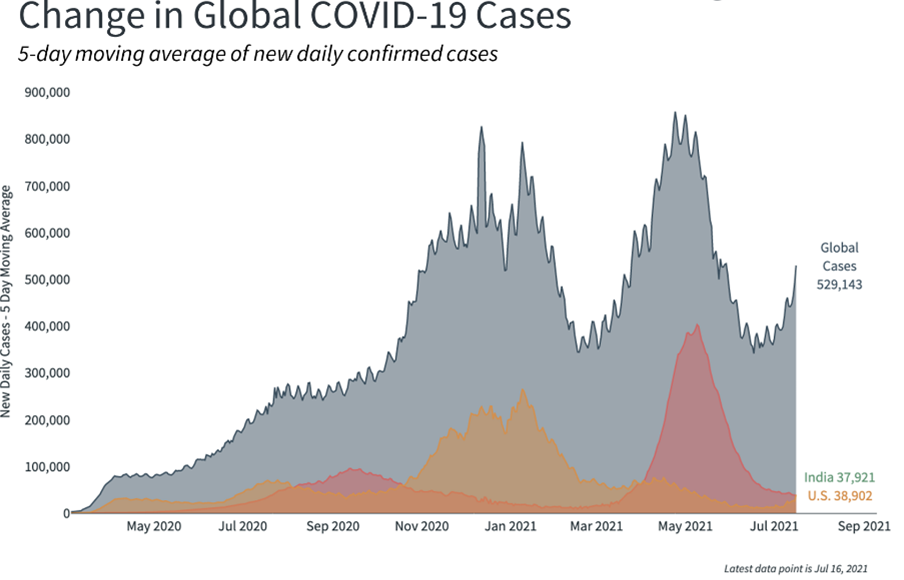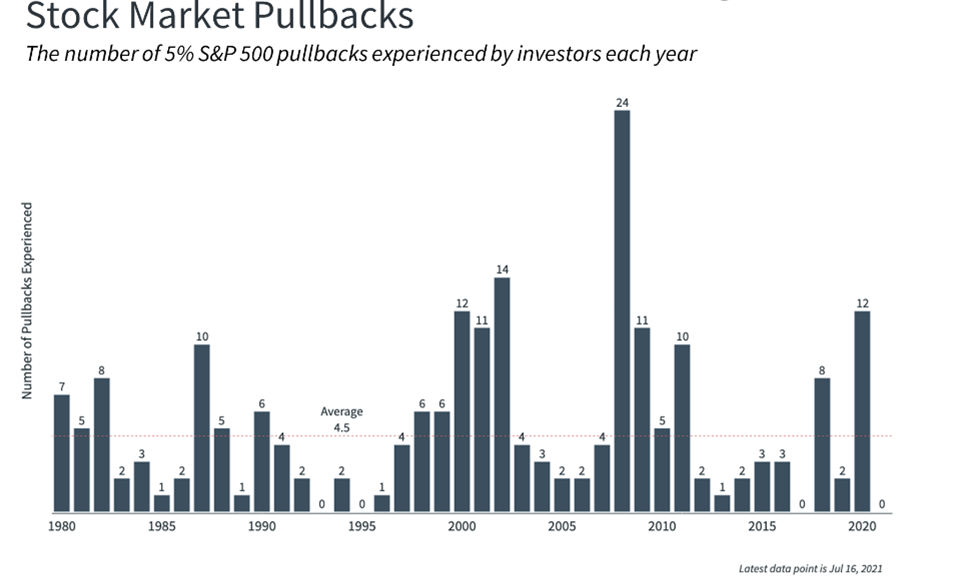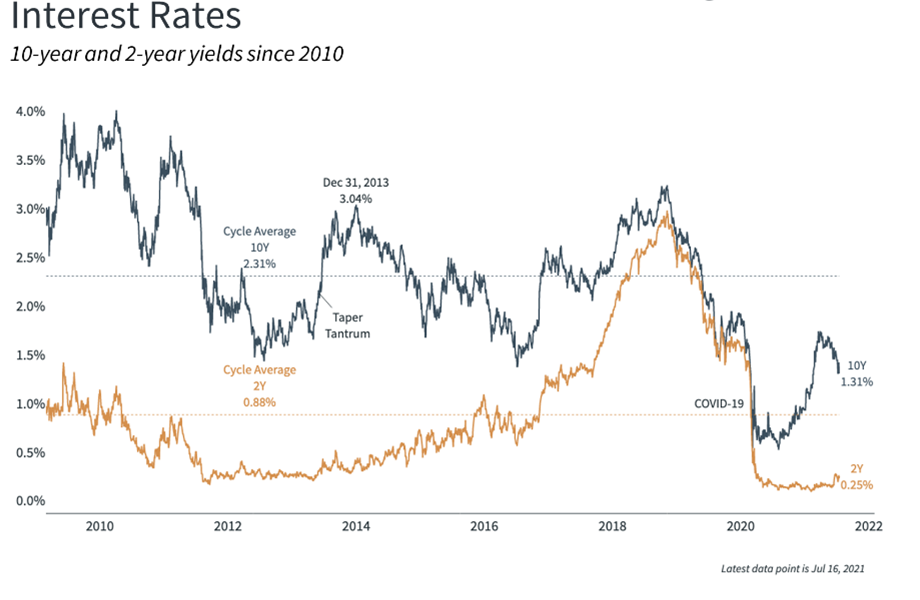Pullbacks: A Natural and Manageable Part of Investing
2Q 2021
Written by Todd Brand, AIF®
“Economics is extremely useful as a form of employment for economists.”
– John Kenneth Galbraith
So, take these thoughts with a grain of salt, as we will be dabbling not just in economics, but also infectious diseases’ impacts on them.
As it often does, the stock market has hit a rough patch due to concerns around the Delta variant, economic growth, interest rates and more… and then bounced back near record highs anyway. Although no two market paths are exactly alike, there have already been several periods of short-term volatility this year in response to similar headlines. For long-term investors, it’s important to remember that these setbacks are a natural, expected, and manageable part of investing.
Many daily headlines are focused on the fact that COVID-19 cases have begun to rise again in the U.S. and globally, driven by the Delta variant. While the public health crisis continues to be severe outside the U.S., the market impact today could be quite different from other spikes in cases over the past 18 months. Not only are existing vaccines reported to be effective against the variant, but markets already know what to expect in terms of the range of economic effects. In any situation, it is less likely today that cities will be placed on lockdown, much less the entire country. Markets seem to know this.
Despite this, it is natural for some investors to be concerned. Stock market pullbacks are never pleasant, especially when they occur unexpectedly (which is kind of the only way they do occur). Pullbacks are a completely normal part of investing. One source of this dissonance is the uncertainty that investors perceive compared to actual market performance. So far this year, the largest peak-to-trough pullback has been less than -5%[1]… despite what one might think from the constant flurry of headlines and concerns.
In contrast, the average year experiences three distinct 5% pullbacks.[2] Whether or not there is a prolonged market correction or economic recession, each pullback feels as if it will last indefinitely. More often than not, however, they turn around rather quickly and markets resume what they do best: reacting to corporate and economic data. In the current environment, with strong underlying growth trends for both companies and the broader economy, there are reasons to be positive despite worrisome headlines.
Of course, this does not mean that there won’t be more volatility ahead or differing impacts across markets. At the moment, interest rates appear to have taken the brunt of the macroeconomic impact. The 10-year U.S. Treasury yield, which has been declining since the first quarter, is now back to February levels.[3] This reflects both a flight-to-safety as investors buy Treasuries as well as uncertainty over the level of inflation. Ultimately, the supply and demand disruptions that pushed inflation higher this year and the consequences of loose monetary policy will be the deciding factors.
Investors should continue to expect periods of stock market volatility. There will always be causes for concern, especially as the business cycle enters a new phase of growth following the initial recovery. Although the Delta variant may be worrisome from a public health perspective, the lesson for investors since last April is that markets can and do look through negative events if there are positive trends. Below are three charts from Clearnomics that help provide perspective on this important topic.
1. COVID Delta variant cases are on the rise

COVID-19 cases have begun to rise again due to the Delta variant. However, not only do existing vaccines appear to be effective at minimizing severe cases and hospitalizations, but markets are also better equipped to understand and react to the ongoing pandemic. Given the previous high number of confirmed cases worldwide, it would be a challenging math problem to see the current trend hit the same lofty peaks of the past as both vaccinations and recoveries continue to build.
2. Despite investor concerns, pullbacks have been small

Despite the perception that the economic landscape is increasingly uncertain, the largest stock market pullback has been smaller than average this year. So far, there has not been a single pullback as large as 5%. Per past articles we’ve shared with you, the AVERAGE year has at least one 14% pullback in it[4] (100% of which later recovered).
3. Interest rates have also fallen in recent weeks

Interest rates have moved in unexpected ways over the past year. Although many expected the 10-year yield to reach 2%, it has reversed over the past 3 months and is now back to February levels. Where rates go from here will depend on growth and inflation trends.
Closing thoughts
So, our purpose in this piece is to both affirm the challenge that investing in a risky world can be just that, and simultaneously suggest that people and markets adjust to changing conditions and make their way forward despite those challenges. Like all of the “interesting” times before, this is a good time to have a plan, know the plan, and invest in accordance with the plan with great hope for the future. We’re glad that you let us participate in yours.
[1] MarketWatch, S&P 500 hasn’t fallen 5% from a peak in nearly 200 sessions—what that tells market historians.
[2] LPL Financial Research, Is It Time For A 5% Pullback?
[3] St. Louis Fed, FRED: 10-Year Treasury Constant Maturity Rate.
[4] JP Morgan, The market’s wild ride: What’s driving the volatility?
